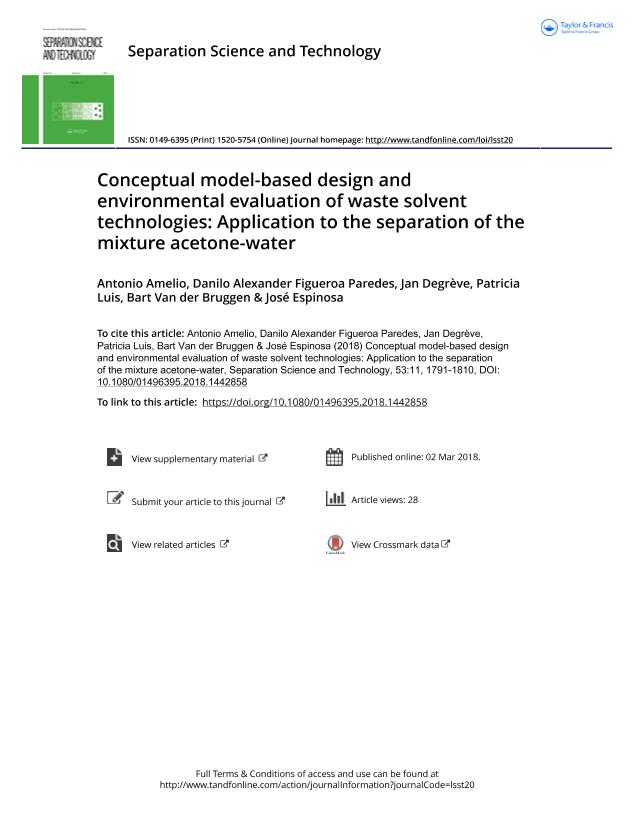Mostrar el registro sencillo del ítem
dc.contributor.author
Amelio, Antonio
dc.contributor.author
Figueroa Paredes, Danilo Alexander

dc.contributor.author
Degrève, Jan
dc.contributor.author
Luis, Patricia
dc.contributor.author
Van der Bruggen, Bart
dc.contributor.author
Espinosa, Hector Jose Maria

dc.date.available
2019-10-23T19:08:27Z
dc.date.issued
2018-07
dc.identifier.citation
Amelio, Antonio; Figueroa Paredes, Danilo Alexander; Degrève, Jan; Luis, Patricia; Van der Bruggen, Bart; et al.; Conceptual model-based design and environmental evaluation of waste solvent technologies: Application to the separation of the mixture acetone-water; Taylor & Francis; Separation Science and Technology; 53; 11; 7-2018; 1791-1810
dc.identifier.issn
0149-6395
dc.identifier.uri
http://hdl.handle.net/11336/87138
dc.description.abstract
In this paper, two waste solvent technologies are presented as alternatives to the disposal of spent acetone-water mixtures. In the first alternative, a batch rectifier is used to concentrate the waste in order to obtain a distillate with a higher calorific value, which is then sent to off-site incineration either in a cement kiln or in a conventional waste solvent incinerator. The second alternative is a hybrid process composed by a batch rectifier and a pervaporation unit that processes in batchwise mode the first cut from the distillation task to obtain a dehydrated solvent. Here, four scenarios are considered, comprising two kinds of membrane materials and two different vacuum systems. For each alternative, the conceptual design was carried out with the aid of conceptual models of the unit operations involved. Quasi-optimal values for design and operation variables were used as input data to perform an economical and an environmental assessment of each alternative. The economic analysis suggests that the hybrid process is the best alternative given that the replacement cost of fresh solvent (about 850 U$S/ton) is considered as a credit value. From the environmental analysis with life cycle assessment, two main conclusions can be drawn: i) the use of the distillate as an alternative fuel in a cement kiln leads to a reduction in emissions that is relevant for the categories related to human health and ecosystem quality; and ii) in terms of resource depletion, the hybrid process distillation/pervaporation with the ceramic membrane HybSi (Pervatech) shows the lowest impact due to the solvent recovery.
dc.format
application/pdf
dc.language.iso
eng
dc.publisher
Taylor & Francis

dc.rights
info:eu-repo/semantics/openAccess
dc.rights.uri
https://creativecommons.org/licenses/by-nc-sa/2.5/ar/
dc.subject
CONCEPTUAL DESIGN
dc.subject
CONSEQUENTIAL LIFE CYCLE ASSESSMENT
dc.subject
DISTILLATION/INCINERATION
dc.subject
DISTILLATION/PERVAPORATION
dc.subject
ECONOMIC ANALYSIS
dc.subject.classification
Ingeniería de Procesos Químicos

dc.subject.classification
Ingeniería Química

dc.subject.classification
INGENIERÍAS Y TECNOLOGÍAS

dc.title
Conceptual model-based design and environmental evaluation of waste solvent technologies: Application to the separation of the mixture acetone-water
dc.type
info:eu-repo/semantics/article
dc.type
info:ar-repo/semantics/artículo
dc.type
info:eu-repo/semantics/publishedVersion
dc.date.updated
2019-10-22T17:46:13Z
dc.journal.volume
53
dc.journal.number
11
dc.journal.pagination
1791-1810
dc.journal.pais
Estados Unidos

dc.description.fil
Fil: Amelio, Antonio. Politecnico di Torino; Italia. Katholikie Universiteit Leuven; Bélgica
dc.description.fil
Fil: Figueroa Paredes, Danilo Alexander. Consejo Nacional de Investigaciones Científicas y Técnicas. Centro Científico Tecnológico Conicet - Santa Fe. Instituto de Desarrollo y Diseño. Universidad Tecnológica Nacional. Facultad Regional Santa Fe. Instituto de Desarrollo y Diseño; Argentina
dc.description.fil
Fil: Degrève, Jan. Katholikie Universiteit Leuven; Bélgica
dc.description.fil
Fil: Luis, Patricia. Université Catholique de Louvain; Bélgica
dc.description.fil
Fil: Van der Bruggen, Bart. Katholikie Universiteit Leuven; Bélgica
dc.description.fil
Fil: Espinosa, Hector Jose Maria. Consejo Nacional de Investigaciones Científicas y Técnicas. Centro Científico Tecnológico Conicet - Santa Fe. Instituto de Desarrollo y Diseño. Universidad Tecnológica Nacional. Facultad Regional Santa Fe. Instituto de Desarrollo y Diseño; Argentina
dc.journal.title
Separation Science and Technology

dc.relation.alternativeid
info:eu-repo/semantics/altIdentifier/url/https://www.tandfonline.com/doi/full/10.1080/01496395.2018.1442858
dc.relation.alternativeid
info:eu-repo/semantics/altIdentifier/doi/http://dx.doi.org/10.1080/01496395.2018.1442858
Archivos asociados
